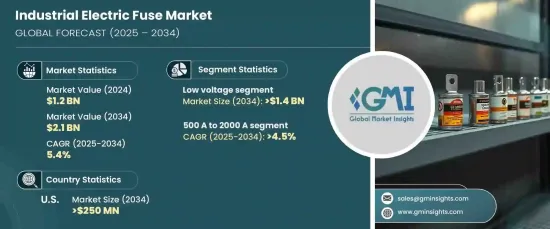 |
市场调查报告书
商品编码
1667093
工业电保险丝市场机会、成长动力、产业趋势分析与 2025 - 2034 年预测Industrial Electric Fuse Market Opportunity, Growth Drivers, Industry Trend Analysis, and Forecast 2025 - 2034 |
||||||
全球工业电保险丝市场将实现显着增长,其估值将在 2024 年达到 12 亿美元,预计在 2025 年至 2034 年期间将以 5.4% 的强劲复合年增长率增长。政府加强输配电网路的倡议,加上汽车产业的蓬勃发展和更严格的保险丝安装安全规范,是推动该市场向前发展的关键因素。

随着工业不断扩张,对电气安全设备的需求不断增加,预计到 2034 年低压市场将创收 14 亿美元。严格的安全法规鼓励业界采用可靠的低压系统保险丝解决方案,确保防止过载和短路。此外,电动车的快速普及和工业基础设施发展的投资也增强了对先进电气元件的需求,从而推动了该领域的成长。
| 市场范围 | |
|---|---|
| 起始年份 | 2024 |
| 预测年份 | 2025-2034 |
| 起始值 | 12亿美元 |
| 预测值 | 21亿美元 |
| 复合年增长率 | 5.4% |
额定电流在 500 A 至 2000 A 之间的保险丝将实现大幅增长,预计 2024 年至 2034 年的复合年增长率为 4.5%。 製造业和能源等行业对自动化和重型机械的依赖日益增加,加剧了对大容量保险丝的需求。先进的安全要求和保护关键基础设施的必要性正在推动创新,製造商推出耐用而高效的解决方案,以满足对安全电气保护系统日益增长的需求。
由于快速的工业成长、广泛的数位转型以及对电力基础设施现代化的大量投资,美国工业电保险丝市场预计到 2034 年将达到 2.5 亿美元。升级输电网路、满足不断增长的电力需求以及现代化电网基础设施的努力正在创造有利可图的机会。这些措施与政府提高半导体製造能力和加强国家能源基础设施的策略密切相关。
目录
第 1 章:方法论与范围
- 市场定义
- 基础估算与计算
- 预测计算
- 资料来源
- 基本的
- 次要
- 有薪资的
- 民众
第 2 章:执行摘要
第 3 章:产业洞察
- 产业生态系统分析
- 监管格局
- 产业衝击力
- 成长动力
- 产业陷阱与挑战
- 成长潜力分析
- 波特的分析
- 供应商的议价能力
- 买家的议价能力
- 新进入者的威胁
- 替代品的威胁
- PESTEL 分析
第四章:竞争格局
- 介绍
- 战略仪表板
- 创新与永续发展格局
第 5 章:市场规模与预测:按电压,2021 – 2034 年
- 主要趋势
- 低的
- 高的
第 6 章:市场规模与预测:按当前评级,2021 年至 2034 年
- 主要趋势
- 500A-2000A
- 2000-4000A
- >4000安
第 7 章:市场规模及预测:按地区,2021 – 2034 年
- 主要趋势
- 北美洲
- 我们
- 加拿大
- 墨西哥
- 欧洲
- 英国
- 挪威
- 德国
- 义大利
- 荷兰
- 亚太地区
- 中国
- 日本
- 印度
- 韩国
- 中东和非洲
- 沙乌地阿拉伯
- 阿联酋
- 土耳其
- 拉丁美洲
- 巴西
- 阿根廷
第八章:公司简介
- ABB
- Bel Fuse
- Carling Technologies
- C&S Electric
- Denco Fuses
- DF Electric
- Eaton
- Fuji Electric
- Hager Group
- Legrand
- Littelfuse
- Mersen
- Optifuse
- S&C Electric Company
- Schneider Electric
- SCHURTER Global
- Siba
- Socomec
- SOC Corporation
The Global Industrial Electric Fuse Market is set to achieve remarkable growth, with its valuation hitting USD 1.2 billion in 2024 and projected to expand at a robust CAGR of 5.4% from 2025 to 2034. This surge is fueled by rapid industrialization and the widespread adoption of digital technologies across key sectors such as manufacturing, automotive, and energy. Government initiatives to enhance power transmission and distribution networks, coupled with the dynamic growth of the automotive industry and stricter safety norms for fuse installations, are key factors propelling this market forward.

The low voltage segment is expected to generate USD 1.4 billion by 2034, driven by the escalating demand for electrical safety devices amid ongoing industrial expansion. Stringent safety regulations are encouraging industries to adopt reliable fuse solutions for low voltage systems, ensuring protection against overloads and short circuits. Additionally, the rapid adoption of electric vehicles and investments in industrial infrastructure development are bolstering the need for advanced electrical components, fueling growth in this segment.
| Market Scope | |
|---|---|
| Start Year | 2024 |
| Forecast Year | 2025-2034 |
| Start Value | $1.2 billion |
| Forecast Value | $2.1 Billion |
| CAGR | 5.4% |
Fuses with current ratings between 500 A and 2000 A are poised for significant growth, with a CAGR of 4.5% forecasted from 2024 to 2034. The increasing reliance on automation and heavy machinery in industries such as manufacturing and energy has intensified the demand for high-capacity fuses. Advanced safety requirements and the imperative to protect critical infrastructure are driving innovation, with manufacturers introducing durable and efficient solutions to meet the rising demand for secure electrical protection systems.
The U.S. industrial electric fuse market is projected to reach USD 250 million by 2034, bolstered by rapid industrial growth, widespread digital transformation, and significant investments in power infrastructure modernization. Efforts to upgrade transmission networks, address growing power demands, and modernize grid infrastructure are creating lucrative opportunities. These initiatives are closely aligned with government strategies to enhance semiconductor manufacturing capabilities and strengthen the nation's energy infrastructure.
Table of Contents
Chapter 1 Methodology & Scope
- 1.1 Market definitions
- 1.2 Base estimates & calculations
- 1.3 Forecast calculation
- 1.4 Data sources
- 1.4.1 Primary
- 1.4.2 Secondary
- 1.4.2.1 Paid
- 1.4.2.2 Public
Chapter 2 Executive Summary
- 2.1 Industry synopsis, 2021 - 2034
Chapter 3 Industry Insights
- 3.1 Industry ecosystem analysis
- 3.2 Regulatory landscape
- 3.3 Industry impact forces
- 3.3.1 Growth drivers
- 3.3.2 Industry pitfalls & challenges
- 3.4 Growth potential analysis
- 3.5 Porter's analysis
- 3.5.1 Bargaining power of suppliers
- 3.5.2 Bargaining power of buyers
- 3.5.3 Threat of new entrants
- 3.5.4 Threat of substitutes
- 3.6 PESTEL analysis
Chapter 4 Competitive Landscape, 2024
- 4.1 Introduction
- 4.2 Strategic dashboard
- 4.3 Innovation & sustainability landscape
Chapter 5 Market Size and Forecast, By Voltage, 2021 – 2034 (USD Million, ‘000 Units)
- 5.1 Key trends
- 5.2 Low
- 5.3 High
Chapter 6 Market Size and Forecast, By Current Rating, 2021 – 2034 (USD Million, ‘000 Units)
- 6.1 Key trends
- 6.2 500A-2000A
- 6.3 2000-4000A
- 6.4 > 4000A
Chapter 7 Market Size and Forecast, By Region, 2021 – 2034 (USD Million, ‘000 Units)
- 7.1 Key trends
- 7.2 North America
- 7.2.1 U.S
- 7.2.2 Canada
- 7.2.3 Mexico
- 7.3 Europe
- 7.3.1 UK
- 7.3.2 Norway
- 7.3.3 Germany
- 7.3.4 Italy
- 7.3.5 Netherlands
- 7.4 Asia Pacific
- 7.4.1 China
- 7.4.2 Japan
- 7.4.3 India
- 7.4.4 South Korea
- 7.5 Middle East & Africa
- 7.5.1 Saudi Arabia
- 7.5.2 UAE
- 7.5.3 Turkey
- 7.6 Latin America
- 7.6.1 Brazil
- 7.6.2 Argentina
Chapter 8 Company Profiles
- 8.1 ABB
- 8.2 Bel Fuse
- 8.3 Carling Technologies
- 8.4 C&S Electric
- 8.5 Denco Fuses
- 8.6 DF Electric
- 8.7 Eaton
- 8.8 Fuji Electric
- 8.9 Hager Group
- 8.10 Legrand
- 8.11 Littelfuse
- 8.12 Mersen
- 8.13 Optifuse
- 8.14 S&C Electric Company
- 8.15 Schneider Electric
- 8.16 SCHURTER Global
- 8.17 Siba
- 8.18 Socomec
- 8.19 SOC Corporation











